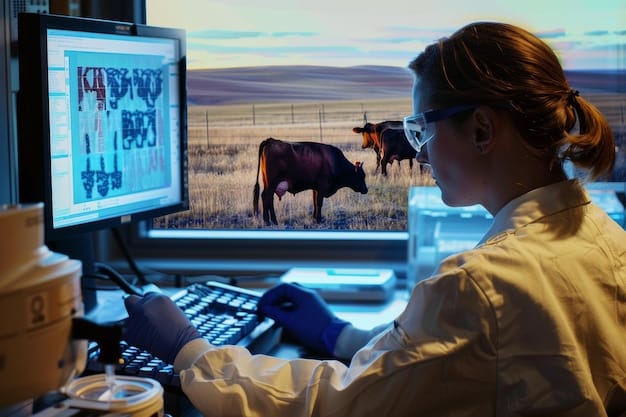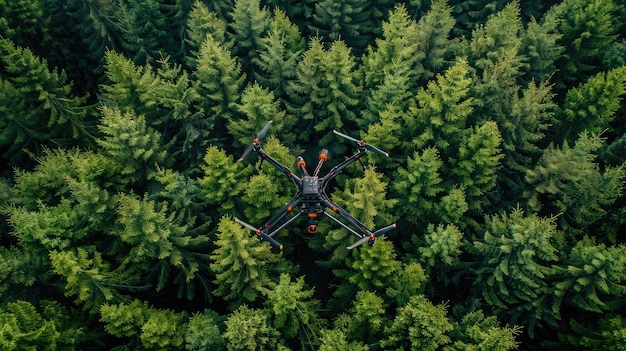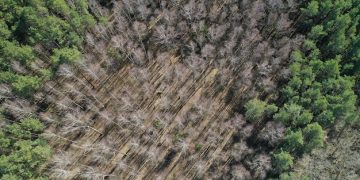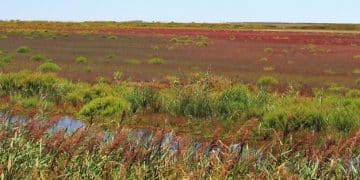Latest Advancements in Wildlife Disease Management & Prevention

Recent developments in wildlife disease management and prevention encompass advanced surveillance techniques, innovative vaccines, and collaborative international efforts to protect ecosystems and human health.
What are the cutting-edge strategies transforming how we protect our planet’s diverse species? The latest advancements in wildlife disease management and prevention are revolutionizing conservation efforts and safeguarding ecosystems.
Understanding the Emerging Landscape of Wildlife Diseases
Wildlife diseases are an ever-present threat, impacting biodiversity and ecological balance. To effectively combat these challenges, it’s crucial to understand the factors that contribute to their emergence and spread. This section delves into the core issues surrounding wildlife diseases and their management.
Understanding what’s driving disease emergence and how those things interact with the wildlife that’s getting sick is key for proper management. Without that, it is difficult to prevent future situations.
Factors Contributing to Disease Emergence
Several factors play a role in the rise of wildlife diseases, including habitat loss, climate change, and human-wildlife interactions. Each of these elements can disrupt ecosystems and stress animal populations, increasing their vulnerability to disease.
For example, habitat loss forces animals into closer proximity, facilitating the spread of pathogens. Similarly, climate change can alter the distribution of disease vectors, exposing wildlife to novel diseases.
The Role of Surveillance in Early Detection
Effective surveillance is essential for the early detection and management of wildlife diseases. By monitoring wildlife populations for signs of illness, researchers can identify outbreaks and implement control measures before they escalate.
Surveillance programs often involve collecting samples from wild animals and testing them for a variety of pathogens but also analyzing larger events like mass mortalities.
- Habitat Loss: Forces animals closer together, increasing disease transmission.
- Climate Change: Alters disease vector distribution, exposing wildlife to new pathogens.
- Human-Wildlife Interactions: Facilitate the spread of diseases between humans and animals.
- Effective Surveillance: Essential for early detection and rapid response to outbreaks.
In conclusion, understanding the factors driving disease emergence and implementing proactive surveillance measures are crucial for effective wildlife disease management. These efforts help protect biodiversity and maintain the health of ecosystems.
Advanced Diagnostic Techniques for Wildlife Diseases
Accurate and rapid diagnosis is critical in wildlife disease management. Traditional diagnostic methods are evolving with the advent of new technologies. This section explores some of the advanced diagnostic techniques that are revolutionizing the field.
The development and use of new testing tools is a constant area of discussion in wildlife health. It is important that testing is accurate, rapid, and easily deployed in situ.

Genetic Sequencing and Pathogen Identification
Genetic sequencing is transforming how diseases are diagnosed. It allows scientists to identify pathogens quickly and accurately, even if they are previously unknown. This technology enables targeted treatment and prevention strategies.
Methods such as metagenomics are becoming increasingly common in labs analyzing wildlife samples. This is used to get genetic information from a myriad of samples and can allow for better identification of pathogens.
Remote Sensing and Disease Mapping
Remote sensing technologies, such as satellite imagery and drones, are now being used to map disease outbreaks. These tools can identify environmental factors that contribute to disease spread, helping to predict and prevent future outbreaks.
By analyzing data from remote sensors, researchers can create detailed maps of disease prevalence and identify high-risk areas. This allows for targeted interventions, such as habitat management and vaccination programs.
In summary, advanced diagnostic techniques are essential for accurate and rapid disease detection. These technologies enable informed decision-making and effective wildlife disease management, protecting both wildlife and human health.
- Genetic Sequencing: Enables rapid and accurate pathogen identification.
- Metagenomics: Provides genetic information from diverse samples for pathogen identification.
- Remote Sensing: Maps disease outbreaks and identifies environmental factors.
- Disease Mapping: Helps predict and prevent future outbreaks.
Innovative Vaccination Strategies for Wildlife
Vaccination is one of the most effective tools for preventing and controlling infectious diseases in wildlife populations. Innovative strategies, such as oral vaccines and targeted delivery systems, are improving the reach and impact of vaccination efforts. This section explores some of these cutting-edge approaches.
Wildlife vaccinations are very challenging because of the logistics surrounding giving a wild animal a vaccine. However, there are several successful case studies for how to make it work and prevent serious diseases.
Oral Vaccines and Bait Delivery Systems
Oral vaccines are an efficient way to immunize large populations of wildlife against specific diseases. These vaccines are often delivered in baits, which animals consume voluntarily. This approach has been successful in controlling rabies and other diseases in various species.
Bait delivery systems allow for wide-scale vaccination with minimal handling of animals. The vaccines are designed to be stable and effective when ingested, providing long-lasting immunity.
Targeted Delivery Systems
Targeted delivery systems offer another way to immunize wildlife populations. These systems use drones or other methods to deliver vaccines directly to animals in remote or inaccessible areas. This approach ensures that vaccines reach the animals that need them most.
Targeted delivery can also be used to administer vaccines to specific age groups or populations within a species. This allows for more precise control of disease outbreaks and improved overall herd immunity.

In conclusion, innovative vaccination strategies are essential for preventing and controlling infectious diseases in wildlife populations. These approaches improve the reach and effectiveness of vaccination efforts, safeguarding biodiversity and public health.
- Oral Vaccines: Efficiently immunize large wildlife populations.
- Bait Delivery Systems: Enable wide-scale vaccination with minimal handling.
- Targeted Delivery Systems: Deliver vaccines to specific animals in remote areas.
- Improved Herd Immunity: Enhances overall protection against disease outbreaks.
The Crucial Role of Habitat Management in Disease Prevention
Habitat management plays a vital role in preventing wildlife diseases. By creating and maintaining healthy ecosystems, we can reduce the risk of disease outbreaks and enhance the resilience of wildlife populations. This section explores the importance of habitat management in disease prevention.
Healthy habitats are the basis to healthy wildlife populations. If a population is stressed due to poor nutrition or lack of water, they will be more susceptible to disease.
Maintaining Biodiversity and Ecosystem Health
Biodiversity is key to maintaining healthy ecosystems. Diverse habitats provide a buffer against disease outbreaks by reducing the likelihood of pathogen transmission between species. Protecting and restoring biodiversity can enhance the natural immunity of wildlife populations.
Ecosystem health is also essential for disease prevention. Healthy ecosystems provide resources that wildlife need to thrive, such as food, water, and shelter. By maintaining ecosystem health, we can support the overall well-being of wildlife populations and reduce their susceptibility to disease.
Reducing Human-Wildlife Conflict
Human-wildlife conflict can increase the risk of disease transmission. When humans and wildlife come into close contact, there is a greater chance of diseases jumping between species. Managing habitats to minimize human-wildlife conflict can reduce the risk of disease outbreaks.
Strategies such as creating buffer zones between human settlements and wildlife habitats can help to reduce conflict. These measures not only protect wildlife but also safeguard human health by reducing the risk of zoonotic disease transmission.
In summary, habitat management is crucial for preventing wildlife diseases. By maintaining biodiversity, ecosystem health, and reducing human-wildlife conflict, we can create resilient wildlife populations that are less susceptible to disease.
- Maintaining Biodiversity: Reduces pathogen transmission between species.
- Ecosystem Health: Provides essential resources for wildlife well-being.
- Reducing Human-Wildlife Conflict: Minimizes disease transmission risks.
- Buffer Zones: Protect wildlife and safeguard human health.
Collaborative International Efforts in Wildlife Disease Management
Wildlife diseases do not respect national boundaries, making international collaboration essential. This section examines the role of collaborative international efforts in wildlife disease management.
Because animals can move large distances, or even migrate between countries, it is important to have good agreements for how to handle disease crossing borders. This ensures protection of wildlife does not stop at any arbitrary, artificial location.
Sharing Data and Expertise
Sharing data and expertise is crucial for effective wildlife disease management. International organizations, such as the World Organisation for Animal Health (WOAH) and the Convention on International Trade in Endangered Species (CITES), facilitate the exchange of information and best practices between countries. This allows for a coordinated response to disease outbreaks.
By sharing data on disease prevalence, genetic information, and control strategies, countries can learn from each other’s experiences and improve their own disease management efforts. This collaborative approach is essential for protecting wildlife populations worldwide.
Coordinated Response to Outbreaks
A coordinated response to disease outbreaks is essential for minimizing the impact on wildlife populations. When a disease outbreak occurs, international collaboration can help to mobilize resources, provide technical assistance, and implement control measures. This coordinated approach ensures that outbreaks are contained quickly and effectively.
International organizations often play a key role in coordinating these responses. They bring together experts from different countries to develop strategies for controlling the outbreak and preventing further spread.
In summary, collaborative international efforts are essential for effective wildlife disease management. By sharing data, expertise, and coordinating responses to outbreaks, we can protect wildlife populations and safeguard global health.
- Sharing Data and Expertise: Facilitates coordinated responses to disease outbreaks.
- Mobilizing Resources: Provides technical assistance and implements control measures.
- Coordinated Response: Ensures outbreaks are contained quickly and effectively.
- Protecting Wildlife: Safeguards global health through collaboration.
The Impact of Climate Change on Wildlife Disease Dynamics
Climate change is altering the distribution and prevalence of wildlife diseases. Rising temperatures, changing rainfall patterns, and extreme weather events can all impact the dynamics of disease transmission. This section examines the impact of climate change on wildlife disease.
Climate change has important effects on wildlife health. It can cause increases in habitat loss, or increases in extreme weather. Both of those things will stress wildlife populations and make them more likely to get sick.
Altered Disease Vector Distribution
Climate change is causing the distribution of disease vectors, such as mosquitoes and ticks, to shift. As temperatures rise, these vectors are expanding their range into new areas, exposing wildlife populations to novel diseases. This can have devastating consequences for species that have not evolved immunity to these pathogens.
For example, the northward expansion of ticks is exposing moose populations to new diseases, such as winter tick, which can cause significant mortality. Monitoring these changes in vector distribution is essential for predicting and preventing disease outbreaks.
Increased Disease Transmission Rates
Climate change can also increase disease transmission rates. Warmer temperatures can accelerate the development of pathogens, allowing them to replicate more quickly and infect more hosts. This can lead to more frequent and severe disease outbreaks.
In addition, changes in rainfall patterns can impact the availability of water sources, forcing animals to congregate in smaller areas and increasing the risk of disease transmission. Understanding these complex interactions is essential for managing wildlife diseases in a changing climate.
- Altered Vector Distribution: Exposes wildlife populations to new diseases.
- Increased Transmission Rates: Leads to more frequent and severe outbreaks.
- Extreme Weather Events: Stresses wildlife populations and increases disease susceptibility.
- Habitat Loss: Reduces wildlife resilience to disease.
In conclusion, climate change is having a significant impact on wildlife disease dynamics. By understanding these impacts and implementing proactive management strategies, we can protect wildlife populations and mitigate the consequences of climate change.
| Key Point | Brief Description |
|---|---|
| 🔬 Genetic Sequencing | Rapidly identifies pathogens for targeted treatment. |
| 💉 Oral Vaccines | Efficiently immunizes large wildlife populations via bait. |
| 🌍 International Coordination | Shares data and expertise for effective responses. |
| 🌡️ Climate Change Impact | Alters disease vector distribution and transmission rates. |
Frequently Asked Questions (FAQ)
▼
Key challenges include the complexity of ecosystems, limited resources for research and management, and the difficulty of monitoring and controlling diseases in wild populations.
▼
The public can assist by reporting sick or dead animals, supporting conservation efforts, reducing habitat destruction, and following guidelines to prevent disease spread.
▼
Zoos and aquariums contribute by providing opportunities for disease research, conducting health monitoring, and implementing preventive measures in managed wildlife populations.
▼
Oral vaccines are highly effective for controlling diseases like rabies by immunizing large populations with minimal handling, reducing disease prevalence and transmission.
▼
Long-term effects involve shifts in disease distribution, increased disease transmission rates, and greater susceptibility of wildlife populations due to habitat loss and stress.
Conclusion
In conclusion, the continuous advancements in wildlife disease management and prevention are essential for preserving our planet’s biodiversity and ensuring the health of ecosystems. From advanced diagnostic techniques to innovative vaccination strategies and collaborative international efforts, these developments represent significant strides in our ability to protect wildlife from emerging and existing threats, safeguarding their future and the health of our planet.





